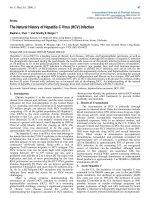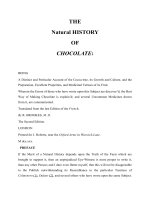THE NATURAL HISTORY OF BRITISH INSECTS VOL 07, DONOVAN
Bạn đang xem bản rút gọn của tài liệu. Xem và tải ngay bản đầy đủ của tài liệu tại đây (9.5 MB, 356 trang )
THE
NATURAL HISTORY
O
F
BRITISH INSECTS;
IN
EXPLAINING THEM
THEIR SEVERAL STATES,
WITH THE PERIODS OF THEIR TRANSFORMATIONS,
THEIR FOOD, OECONOMY, &c.
TOGETHER WITH THE
HISTORY OF SUCH MINUTE INSECTS
AS
REQUIRE INVESTIGATION BY THE MICROSCOPE.
THE WHOLE ILLUSTRATED By
COLOURED FIGURES,
DESIGNED AND EXECUTED FROM EIVING SPECIMENS,
By
E.
DONOVAN.
VOL.
VII.
LONDON:
Printed for the Author,
And
for F,
and
CRivington, N°
62, St,
M DCC XCVIIL
Paul's Church-Yard.
QL
.
St*37
M
S9
[
PLATE
3
CCLXXIV;
FIG.
PHAL^ENA humuli,
I. II.
Ghost MoTti.
GENERIC CHARACTER.
Antennae taper from the bafe
:
wings
in general defle&ed
when
at
Fly by night.
reft.
SPECIFIC CHARACTER
AND
SYNONYMS.
Female yellow, with fulvous marks.
PhaljENA Humuli
Syji.
:
alis flavis
fulvo
Male fnowy white.
ftriatis
maris niveis.
Linn*
Nat. 2. Si3. £4>.—Fn. Sv. 1147.
Hepialus Humuli:
tab. Ent. SyJi.T. S. p. 2.5. fp.
1.
Degeer, Inf. 1. tab.t. fig. 5, 6.
Sulz. Hifl. Inf. tab. 22. Jig.
1.
The male and female of Phalana Humuli are very dimmilar, and
may eafily be miftaken for diftina fpecies. The male is perfeaiy
the abdomen, antennas, and margin of
white, with a glofs like fatin,
The female is of a
are reddifh brown.
the wings excepted, for thefe
fine yellow
fomewhat
colour,
with feveral fulvous or orange marks
;
and
is
larger than the other fex.
roots of the Burdock and bop.
larva lives in the earth, at the
with a brown head, and has
colour,
of a very pale or whitilh
The
It is
fixteen feet.
fs
no.
PLATE
60
F
CCLXXIV.
G.
I
III.
PHAL^NA
H ECTA.
Golden Swift Moth.
SPECIFIC CHARACTER
AND
SYNONYMS.
Wings
yellow, the anterior pair with
two yellow bands of
inter-
rupted dots.
Phal^naHecta:
lutea, alls deflexis
primoribus
:
Fn. Sv.
albidis obliquis punctata interruptis.
Gmel. Linn.
Hepialus Hectus.
S\jl.
This fpecies
is
1
148.—
Nat. Ent. p. 2617. fp. 85.
Fab. Ent. Syji. T.S.p. 2. p. 6. Sp. 4.
Degeer. Inf.
The
duabus
fafciis
7. fig. 11.'
1. tab.
common
in the fkiits of
colours in the male In feci: are
more
woods
in
May
and June.
vivid than the female, and
the fpots on the anterior wings in particular are of fuch a beautiful
yellow, that Englilh collegers have termed this kind
the
Golden
Swift Moth.
It
commences
its
flight earlier in the
the nofturnal lepidopterous infefts.
Its
evening than any other of
manner of
lingular, and attracted the notice of Linnseus,
it
to the
The
who
flying
is
ver
aptly compare!
motion of the pendulum of a clock.
larva
is
unknown
*.
it
is
fuppofed to feed on the roots
of
plants under ground.
PLATE
15
C
1
PLATE
CXIV.
PHALiENA COSSUS.
Goat Moth,
lepidoptera.
GENERIC CHARACTER.
Wings
Antennas taper from the bafe.
at reft.
m
general contracted
when
Fly by night.
SPECIFIC CHARACTER,
AND
STNONTMS-
1
Grey> with
fliort
black irregular curved lines on the upper wings.
Antennas feathered.
Phaljena Cossus.
Bomhyx
elinguis,
thorace
Nat.
PHALiENA
2.
fafcia
504. 40.
pe&inicornis elinguis,
alis
nigris.
Geoff.
Inf. 2.
nebulofis,
deflexis
edit.
Linn.
Syjl.
10.
albo cinereis,
nebulofis
Degeer
alis
poftica atra.
ftriis tranfverfis
abdomine annulis
albis.
102. 4.
Inf. Vers.
Merian. Eur op.
Germ.
2. I.
268.
I.
tab. 36.
Roef. Inf. i.phal. 2. tab. 18.
Reaum.
(
Inf. 1. tab. ij.fig. I. 5*
Albin. Inf. tab. 35. fig. 56.
Lyonet Traite de Chenille.
Schceff. Icon. tab. 61. fig. 1. 2.
Goed. Inf. 2. tab, 33.
The
PLATE
16
The
Caterpillar of the
of willow trees
we
;
it is faid
Goat Moth
CXIV.
feeds
to be alfo found in the
have never difcovered any
internal fubftance
on the
body of the oak, but
in fuch a fituatiom
The
eggs are
-laid
as foon as
the Caterpillars are hatched,
they begin to pierce into the folid wood.
In moft parts of England
in the crevices of the trees
Worms
Auger
they are called
timber appearing as
if
;
;
;
when
full
fed
it
very flefhy, and without hairs
fharp forceps
which
it
;
the cafe
is
is
the head
;
web
;
it
Fly
;
it
armed with very
of wood and faw-duft
infide is
it
transformed
the body appears
black, and
bits
is
lined
pafTes to the
with a
pupa
fine
ftate in
has perforated in the caterpillar ftate, within
three
or four inches of the opening
ftate before the
is
the
.finooth white filmy fubftance, like fattin
which
before
four inches long,
compofed of
unites with a ftrong
the cavity
in the
bored with that Inftrument.
It lives in the Caterpillar ftate three years
to a pupa
make
the holes which they
is
:
it
remains only two months in that
produced.
Is found in chryfalis in
May
;
in the fly ftate, the latter
end of June,
©r in July.
PLATE
/J1
[
27
]
PLATE
CLII.
PHAL^NA AESCULI.
Wood
Leopard Moth.
Lepidoptera.
GENERIC CHARACTER.
Antennae taper from the bafe.
reft.
Wings
in general deflexed
when at
Fly by night.
SPECIFIC CHARACTER
A
SS
SYNONYMS.
Wings
white, with
many
dark blue round fpots.
Six fpotsonthe
Thorax.
Phalana Aesculi
:
elinguis lasvis nivea, antennis thorace brevio-
ribus, alis punftis numerofis cceruleo nigris, thorace
fenis.
Bombyx
Man/.
Aejculi.
Hepialus Aejculi.
Lin. Syji. Nat. 2. 833. 83
— Fn. Sv.
1
150.
Inf. 2. 116. 85.
Fab. Spec. Inf. 2. 208. 146. 4.
Coflus Aefculi.
Wien. Vsrzeichn.tab.
/it.
prof. AclaSoc. BeroJ.phyf.
3. tab. I. fig- 1. 2.
Pod. Inf. 88. 16.
Wood
It is to
Leopard Moth.
Harris
Inf. ang'l.
a very Angular and trivial circumftance
the fpecimens of
both the male and female of
They were obferved
we
are indebted for
this
rare fpecies.
together on the bark of an elm tree in the Mall
in St.
James's Park, by fome ignorant perfons,
their
extraordinary appearance,
who
being
terrified at
attempted to deftroy them,
but a
gentleman
PLATE
88
who happened
gentleman
by
juft before
come out of
in a raoft perfeft ftate,
loft
one of
its
We muff
conclude they could
chryfalides, the female being
and the male equally
it
may
fine,
except that
it
had
upper wings.
readers for the minutenefs with
but,
their
it
ferve to remind
detailed fuch trifling
which we have
can indeed afford very
many who
lecting Infects, that their occafional
of our
fcientific part
more
claim the indulgence of the
circumftances;
from touching
We
them, took them up, and prefervedthem.
have but
having
the fame inftant,
at
curiofity or lefs apprehenfion of danger
more
either
to pafs
CLIL
little
amufement
to them,
are not in the habit of col-
endeavours would be likely to
extend the Science of Entomology; for
often happens that the
it
moft affiduous Naturalifts are indebted to fuch perfons for the
rarefl
fpecimens their cabinets poffefs.
The Moths were found
late in
On
examining the crevices
we found
a quantity of the eggs;
June.
of fome of the trees near the fpot,
they were rather of an oval form, and linked together like a chain,
as
fhewn in the
plate;
and having carefully preferved them in a
branch of a plumb-tree * under the bark,
fome young
to fee
owing
to the
foon
after,
fize.
The
produced
Caterpillars
in a
we had
the fatisfaclion
But
few weeks.
want of proper food or good management they
except two or three, and thefe never arrived
Caterpillar
from which the Figure
the
in
either
all died.
at their full
annexed
is
copied, was found under the bark of one of the elm-trees in St.
James's Park, but being difturbed,
Caterpillar
makes
a
cafe, of the
and cements together, and in
The head of the Caterpillar
this
is
it
never became a Pupa.
it
duff,
of the
lies
wood which
it
The
gnaws,
concealed beneath the bark.
hard, and the
firft
ring
is
furnifhed
with a ilrong horny fubilance,
Harris, about twenty years ago, was
Moth from
the
fo fortunate as to breed
this
and we are not acquainted with
any
find, when the Plant of an InfeS b
unknown,
when they rcfufe other food.
* T frequently
the Plumb-tree,
Caterpillar,
that thev will live
on
fimilar
PLATE
fimilar inftance
fo that
were
it
is
given, but without either
it
vol. 4. a
Pupa or Moth,
not for the reference and authority of Linnaeus, and
fince his time, of Fabricius,
Infeft
29
In the Plates of Roefel,
fince that time.
Figure of the Caterpillar
CLII.
belonged.
The
it
eggs
would fcarcely be known
we have
to
what
not found either figured or
defcribed, though they are fo very Angularly united together, and
would certainly have been noticed by
the ingenious Roefel if he had
met with them.
The Antennae
of the female are fetaceous, or
that part of the male
is
both lingular and
like a briftle,
beautiful
;
it is
but
elegantly
feathered next the bafe. and terminates in a briftle, like the female.
PLATE









